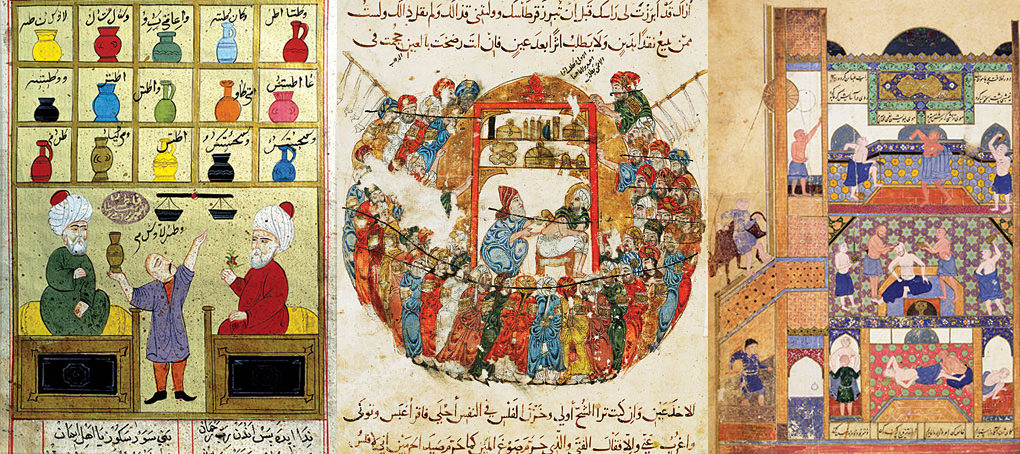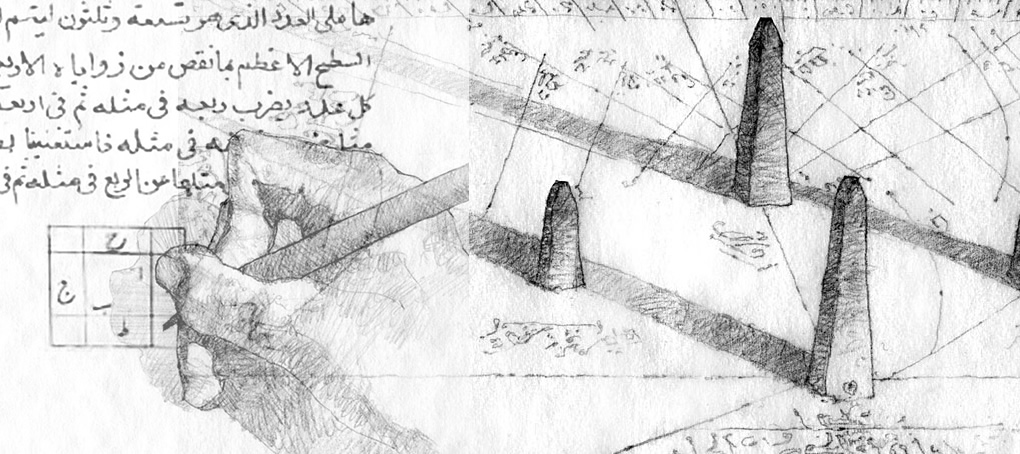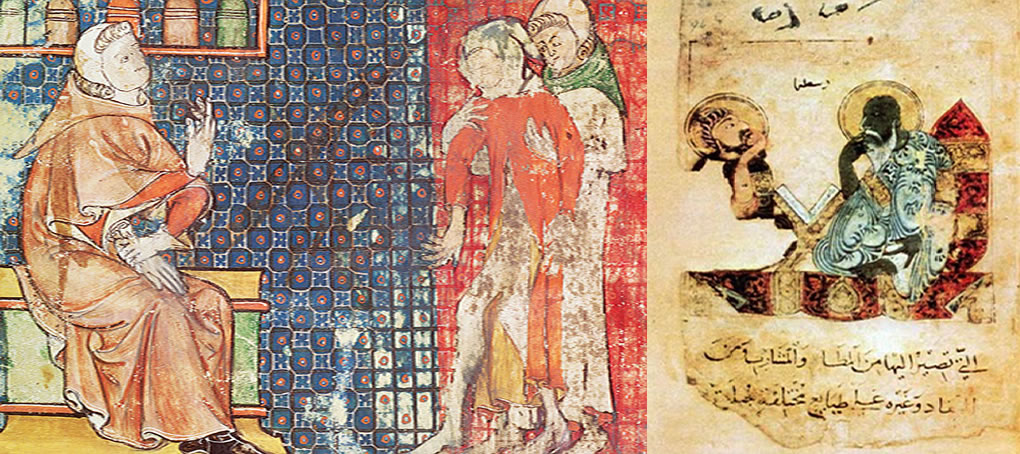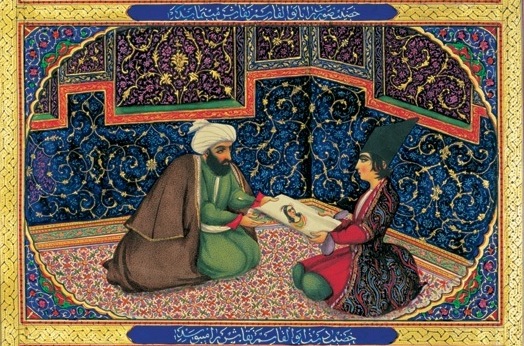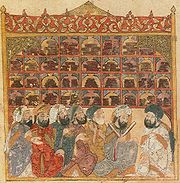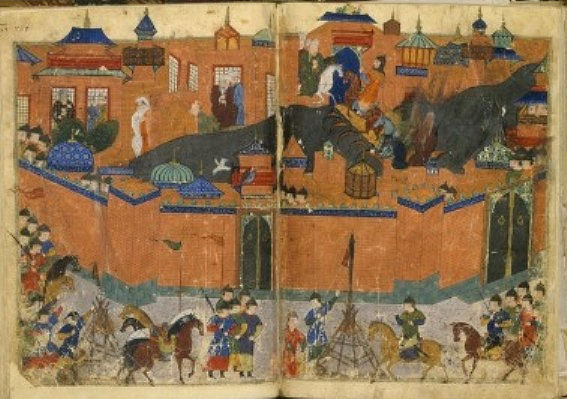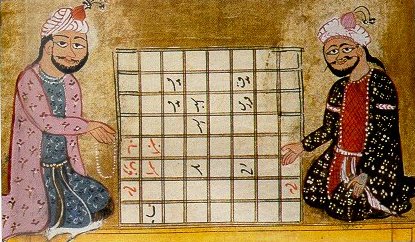The House of Wisdom and the caliphate of Baghdad
|
|
In 758, caliph Al Mansur believed that Baghdad was the perfect city to be the capital of the Islamic empire under the Abbasids and assembled engineers, surveyors, and art constructionists from around the world to come together and draw up plans. The two designers who were hired by al-Mansur to plan the city's design were Naubakht, a Zoroastrian and Mashallah, a Jew from Khorasan, Iran. Baghdad was designed as a circle about 2 km in diameter, leading it to be known as the "Round City". Within the city there were many parks, gardens, villas, and promenades as a direct reflection of the traditional Persian Sasanian urban design which contrasted with Ancient Greek and Roman urban planning. The Abbasids considered themselves the inheritors of two traditions: the Arabian-Islamic (bearers of the mantle of Muhammad) and the Persian (successors to the Sassanid monarchs). Naubakht and Mashallah determined that the date of the foundation should be astrologically auspicious and on July 30, 762, the construction was commissioned so the city would be built under the sign of the lion. The city's growth was helped by its location, which gave it control over strategic and trading routes, along the Tigris. In its early years the city was known as a deliberate reminder of an expression in the Quran, when it refers to Paradise. Within a generation of its founding, Baghdad became a hub of learning and commerce. The Abbasid dynasty had a strong Persian bent and adopted many practices from the Sassanid empire – among those, that of translating foreign works, except that now, works were translated into Arabic. For this purpose, al-Mansur founded a palace library, modeled after the Sassanid Imperial Library named the House of Wisdom. The House of Wisdom was originally established to translate and preserve Persian works, then Syrian and eventually Greek and Sanskrit. Works on mathematics, agriculture, medicine, and philosophy were thus translated. This was the high point of Islamic civilization, when scholars of various religions from around the world headed to Baghdad and to the Bayt al-Hikma (House of Wisdom), transforming the Empire an unrivalled centre for the study of humanities and for sciences, including, astronomy, chemistry, zoology and geography, as well as some more dubious subjects such as alchemy and astrology. Many of the One Thousand and one Nights tales are set in Baghdad during this period. The House of Wisdom was the key institution in the Translation Movement and considered to have been a major intellectual center of the Islamic Golden Age. Many of the most learned Muslim scholars were part of this excellent research and educational society. Drawing on Persian, Indian and Greek texts the scholars accumulated a great collection of world knowledge, and built on it through their own discoveries. Scholars persecuted by the Byzantine Empire were welcomed. The first paper mill was founded by obtaining the secret from Chinese prisoners, facilitating the proliferation of books and libraries and supporting the library with a large number of strationery and book shops. Under the sponsorship of caliph al-Mamun (813 – 833), it seems that the House of Wisdom took on new functions related to mathematics and astrology. The focus also shifted from Persian to Greek texts as the caliph was deeply influenced by Aristotelian thought and Greek rationalism. The concept of the library catalog was introduced and books were organized into specific genres and categories. At that time, the library was directed by the poet and astrologer Sahl ibn Haroun. The House of Wisdom flourished under al-Mamun's first successors. Christian scholar Hunayn ibn Ishaq (809–873) was placed in charge of the translation work by the caliph. While the most renowned translator was the Sabian Thabit ibn Qurra (826–901). Translations of this era were superior to earlier ones, however, soon after, the emphasis on translation work declined, as new ideas became more important. Between other notable scholars associated with the library are Muhammad ibn Musa al-Khwarizmi, the Banu Musa brothers (Mohammed Jafar ibn Musa, Ahmad ibn Musa and al-Hasan ibn Musa), Sind ibn Ali and Yaqub ibn Ishaq al-Kindi. Probably the most famous mathematician at the House of Wisdom was al-Khawarizmi, known as the father of algebra - a word derived from the title of his book, Kitab al-Jabr. Under the reign of al-Mutawakkil ( 847–861), the house declined mainly because the caliph wanted to stop the spread of Greek philosophy and follow the orthodox Islam. The House of Wisdom eventually acquired a reputation as a center of learning, although universities as we know them did not yet exist at this time — transmission of knowledge was done directly from teacher to student, without any institutional surrounding. Schoolsbegan to develop in the city from the 9th century, and in the 11th century the Islamic University of Al-Nizamiyya was founded.Along with all other libraries in Baghdad, the House of Wisdom was destroyed during the Mongol invasion of Baghdad in 1258. |
